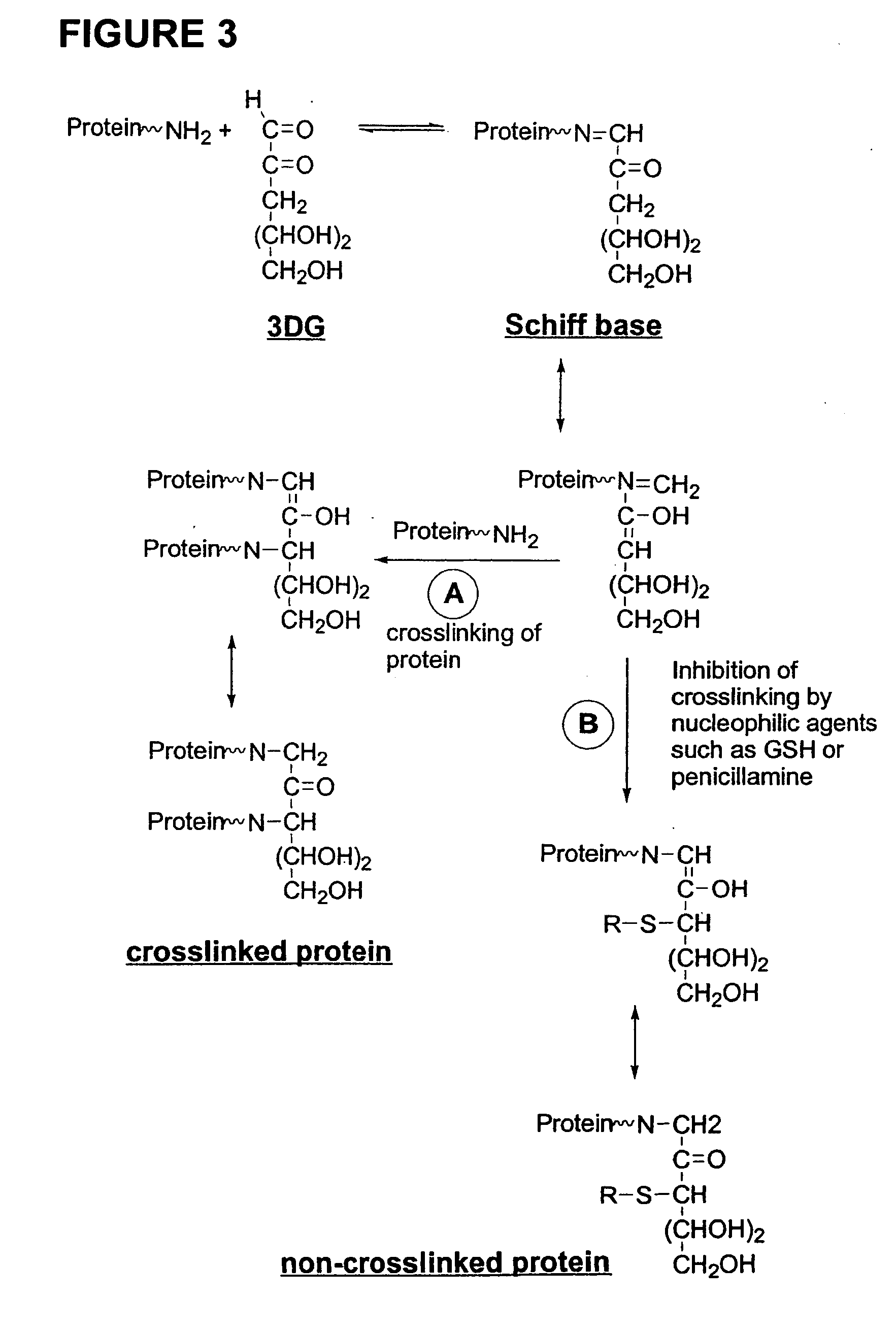Dermal delivery of n-methyl-glucamine and n-methyl-glucamine compounds
a technology of n-methylglucamine and n-methylglucamine, which is applied in the direction of liposomal delivery, pharmaceutical delivery mechanism, toilet preparation, etc., can solve the problems of 3dg compromising the activity of this enzyme, generating various harmful forms of oxygen in the body, and unable to be controlled therapeutically. , to achieve the effect of preventing crosslinking of proteins
- Summary
- Abstract
- Description
- Claims
- Application Information
AI Technical Summary
Benefits of technology
Problems solved by technology
Method used
Image
Examples
example 1
Inhibition of 3DG Collagen Crosslinking In Vitro
[0174] The direct inactivation of 3DG is a method of reducing 3DG levels. Calf skin collagen type 1 (1.3 mg) was incubated with no addition, with 5 mM 3DG, or with 5 mM 3DG plus 10 mM of arginine for 24 hr. Each sample was digested with cyanogen bromide (CnBr) to create peptide fragments that are visualized by sodium-dodecyl sulfate-polyacrylamide gel electrophoresis (SDS-PAGE) (FIG. 4). Lane 2 is collagen alone; lane 3 is collagen plus 5 mM 3DG; and lane 4 is collagen plus 5 mM 3DG plus 10 mM arginine. Lanes 5, 6, and 7 are the same, but with twice as much sample applied.
[0175] Crosslinking was assessed by visually determining the amount of high molecular weight protein remaining near the origin of the resolving gel, as compared to the amount that migrates into the gel matrix. The more crosslinking that exists, the more material there is near the origin of the gel. The lanes containing collagen with 3DG (#3, #6) have more material r...
example 2
Localization of Amadorase mRNA in Skin
[0176] The presence of Amadorase mRNA was analyzed and was utilized as one measure of the ability of skin to produce the 3DG present in skin. PolyA+ messenger RNA isolated from human kidney and skin was obtained from Stratagene. The mRNA was used in RT-PCR procedures. Using the published sequence for human Amadorase (Delpierre et al., 2000, Diabetes 49:1627-1634; Szwergold et al., 2001, Diabetes 50:2139-2147), a reverse primer to the 3′ terminal end of the gene (bp 930-912) was used in a reverse transcriptase reaction to create a cDNA template for subsequent PCR. This same primer was used along with a forward primer from the middle of the Amadorase gene (bp412-431) to amplify a 519 bp fragment. Human skin and kidney samples were subjected to RT-PCR and analyzed by agarose gel electrophoresis, as were controls which contained no cDNA templates.
[0177] A 519 bp product, evidence of Amadorase mRNA was found in both kidney and skin; no such product...
example 3
Localization of 3DG in Skin
[0178] One centimeter (1 cm) squares of skin from six mice were prepared and subjected to extraction with perchloric acid. 3DG was derivatized with a 10-fold excess of diaminonapthalene in PBS. Ethyl acetate extraction provided a salt-free fraction which was converted to the trimethyl silyl ether with Tri-Sil (Pierce). Analysis was performed on a Hewlett-Packard 5890 selected ion monitoring GC-MS system GC was performed on a fused silica capillary column (Hewlett-Packard DB-5 column measuring 25 m×0.25 mm) using the following temperature program: injector port 250° C. at 16° C. / minute and held for 15 minutes. Quantitation of 3DG employed selected ion monitoring using an internal standard of U-13C-3DG.
[0179] The average amount of 3DG detected in the skin was 1.46±0.3 μM. This value was substantially higher than the plasma concentrations of 3DG detected in the same animals (0.19±0.05 μM). These data indicate that the high levels of 3DG in the skin are due ...
PUM
| Property | Measurement | Unit |
|---|---|---|
| Fraction | aaaaa | aaaaa |
| Fraction | aaaaa | aaaaa |
| Fraction | aaaaa | aaaaa |
Abstract
Description
Claims
Application Information
 Login to View More
Login to View More - R&D
- Intellectual Property
- Life Sciences
- Materials
- Tech Scout
- Unparalleled Data Quality
- Higher Quality Content
- 60% Fewer Hallucinations
Browse by: Latest US Patents, China's latest patents, Technical Efficacy Thesaurus, Application Domain, Technology Topic, Popular Technical Reports.
© 2025 PatSnap. All rights reserved.Legal|Privacy policy|Modern Slavery Act Transparency Statement|Sitemap|About US| Contact US: help@patsnap.com



